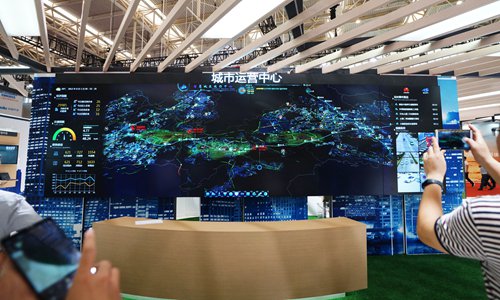
A view of a smart city operating system showcased during the second World Intelligence Congress held in Tianjin, North China, in May, 2018 Photo: IC
China has published an independently developed identification system for cities as part of the smart city infrastructure based on blockchain technology, the Xinhua News Agency reported on Sunday.
The identification system was jointly launched by three institutes in Shijiazhuang, North China's Hebei Province, and cities nationwide have been able to apply for their own city identification code since Sunday.
The bottom-level technology of the system is based on blockchain technology and was self-developed by China, said Zhang Chao, director of the Zhongguancun Industry & Information Research Institute of Two-dimensional Code Technology, one of the developers of the system.
"The system will be independently distributed and managed by China, with a unified distribution rule, a resolution of distributed storage and tamper-resistant code," said Zhang.
The identification code can realize connectivity and data sharing between cities. Its underlying technology combines blockchain services and smart city construction.
"There was no unified code for industries and departments in today's rapid development of the internet and emerging information technology, causing problems of data interoperability and application incompatibility," said He Kejia, Vice President of the China Research Society of Urban Development.
The smart city code system is based on node code in line with international standards. It will assign unique, global digital identification to cities, Xinhua reported.
China began smart city construction in 2016. As increasing numbers of people are moving to cities, new and higher demands are placed on urban planning, construction, management and services, posing huge challenges to infrastructure.
Areas that are closely related to city management are under pressure, including education, medical care, urban water supply and drainage, sewage treatment, gas supply, transportation and environmental protection. Therefore, the construction and development levels of cities must be improved to better meet such development needs.
